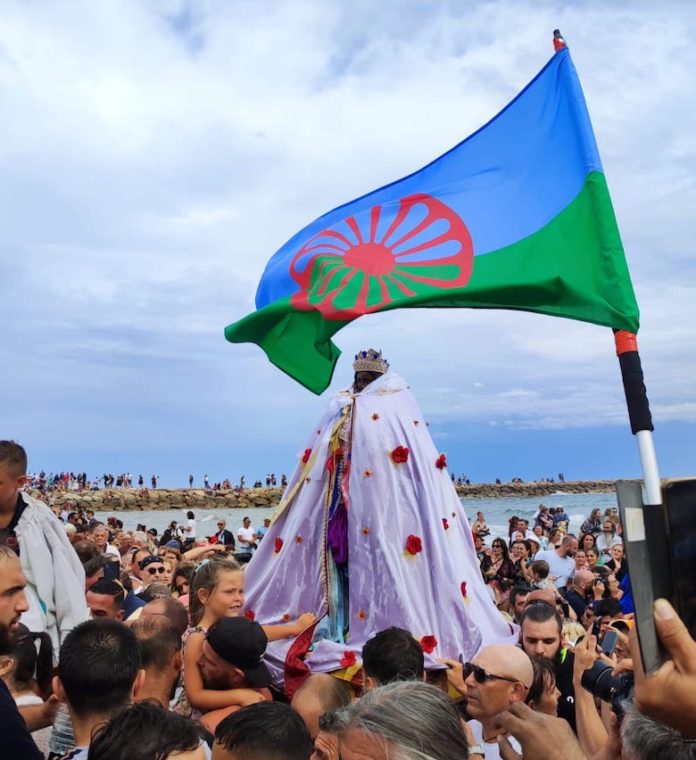The Roma or Romani people, representing the historical diaspora of India, are traditionally nomadic itinerants, but many became sedentary and settled. Roma, who left India probably a millennium ago, are Europe’s largest ethnic minority with the estimated population of 22 million. They are scattered throughout the world.
The Roma community adopted the dominant religion of the countries where they lived, although this was usually superficial and represented a formal adoption fin order to avoid religious persecution. However, some groups of Roma are pagans and Sun worshipers. They do not keep idols yet worship female deity, known as Kali Sara (Kali Bibi) or Saint Sara – Romani goddess of fate, fertility, power, and protection. In order to venerate or worship Kali Sara, many Roma groups, traveling from all over the world, congregate to attend the pilgrimage of Saint Sara and procession at Saintes-Maries de-la-Mer, the commune in the Southern France, on May 24 and 25 each year.
The statue of the Saint Sara is kept in the crypt of the church of Notre-Dame-de-la-Mer (Church of the Saintes Maries de la Mer), popularly known as the Church of Three Maries. The procession, accompanied by mesmerizing Romani music and dance, begins on 24th May when Roma and other Romani groups called Sinti, Gitanos, Manouches, Tsiganes, and etc. from France, Spain, Italy, and other countries flock to revel in the celebration. Roma sing and dance day and night on the streets of Saintes-Maries de-la-Mer and singing prayers in honor of their patroness.
On the day of the pilgrimage, the statue of Kali Sara, donned in the new robes and white glittering tiara, as well as imitation of beaded jewelry, is kept on the pedestal decorated with flowers in the church’s crypt ablazed with devotional candles and votive objects. The statue of Kali Sara is carried in the litter on the shoulders of four Romani people, escorted by an honor guard, from the crypt of the church to the shore of Mediterranean Sea where it is symbolically submerged and subsequently taken back to the reliquary of the church.
The written prayers for curing the sick, good luck, and success in life and business are placed at the feet or near the feet of the Sara’s statue by the Romani pilgrims and devotees who also touch and kiss the face and eyes of the statue for her blessing. No doubt, Saint Sara creates an analogy with goddess Durga in both perceptible manifestation and abstract dimension.
The holy procession includes parading the statue of Kali Sara and is filled with an emotional and religious fervor, accompanied with musical fanfare. The 24th of May has turned out to be Saint Sara’s Day i.e. one of the most revered and important traditions of the European Roma who treat her with the utmost devotion and she is reckoned as a paragon of hope, auspiciousness, and unity. It is also noted that the devotion of Roma towards Saint Sara represents a kind of idolatry, rather than religious practice. Roma were once accused of worshiping “jag & pani” (fire and water) in the pilgrimage. So, they were prohibited from the procession and celebrations in 1895 by prefectural decree which was reversed in 1898.
The story of Saint Sara is tantalizingly obscure, depending on who tells the story. The history of Sara still remains a mystery for historiographers. However, one folktale points to the Egyptian origin of saint. It is also true that “Egyptian” was equivalent to “Romani” during the Middle Age in the Mediterranean Roman Catholic societies. Some Roma were not able to relate their origin geographically to India; therefore, they called themselves “Egyptians”, irrespective of their country of origin – India. Romani people across the world, regardless of their variant subgroup, were acquainted with the fact that their original homeland lies in India, as there is cogent evidence of Indian origin of Roma in several documents dating back to the fifteenth and sixteenth century. Their permanent attachment to the tradition of Indian heritage, as seen in Sara’s rituals, reveals the strong affection for India.
The western scholars Dr. Rajko Djuric and Dr. Ronald Lee along with Indian scholars like Weer Rajendra Rishi and Dr. Lokesh Chandra identified the Romani ceremony of Kali Sara with Durga Puja of India. In Romani cult, Kali Sara is quite similar to Indian goddess known as Kali or Durga. Saint Sara has the appearance of a pagan idol. Like Hindus, Roma too venerate the Shaktism. This analysis establishes the fact that Kali Sara is identically the same as the Indian goddess Durga, who is another aspect of Kali, and the consort of Lord Shiva. The celebration of Sara’s festival in France is seemingly corresponding to the procession of the Kali Puja and Shaivite tradition in India. Even at the first sight one can get the impression of parallelism between these two ceremonies.
Besides festival of Kali Sara, Roma all over the world revere a female divine figure in shrines located near water, called by different names like Bibi, St. Sara, Gugli Sagiya (The guardian Angel) in South Balkans, with similar ceremonies which without doubt, are non-Christian in origin. Roma keep their mutual respect regardless of their respective denominations, and they gather in places of worship called “Lache Than” (Holy Place).
It is now evident that Christianity incorporated the old pagan beliefs. Church has tried to change the style of Roma’s traditional rituals and religious practices as its leaders look down upon the cult of Saint Sara. The Catholics embrace many rituals contrary to those of the Roma/Gypsys in 20thcentury. The introduction of non-Gypsy/non-Romani music in Sara’s pilgrimage seems to be a recent development, as Santino Spinelli (celebrated Romani musician) remarked: “Gypsy festival is without original Gypsy/ Romani music and dance”. There is an attempt to appropriate and adapt the pagan traditions and customs to the Christianity, which is supported by some Evangelical, Catholic, Orthodox, or Pentecostal Romani people. Several groups of Roma pointed out that this represents an attempt to make St. Sara’s role secondary and inferior. They also see the Church as be a Gadje (non-Romani) institution that intends to suppress the beliefs, rites, and rituals of Saint Sara.












